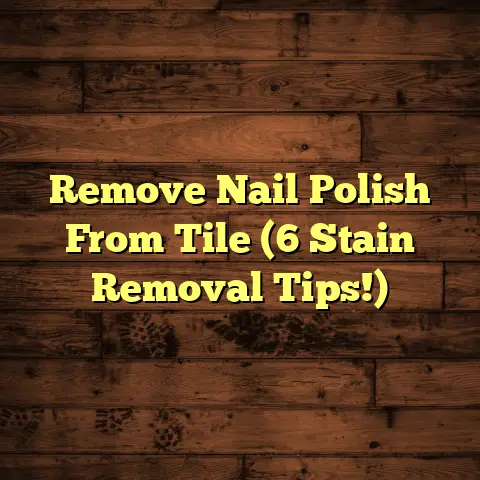Refinish Wood Floors: A DIY Guide (4 Costly Errors!)
(4 Costly Errors!)
Imagine this: It’s Thanksgiving. The aroma of roasted turkey fills the air, and laughter echoes through the house.
Your family gathers around the dining table, sharing stories and creating memories that will last a lifetime.
Underneath it all, grounding the scene, are your wood floors. They’ve seen it all. Kids playing, pets scampering, late-night talks.
Each scratch, each dent tells a story. They’re more than just a surface; they’re a part of your home’s history, a warm embrace.
But time, as it always does, takes its toll. The once-gleaming surface becomes dull, scratched, and worn.
That’s where refinishing comes in. It’s like giving your floors a new lease on life, restoring their beauty and warmth.
And the best part? You can do it yourself! There’s a unique satisfaction in bringing life back to your floors with your own hands.
However, trust me, I’ve seen it all in my years as a flooring contractor – refinishing can be tricky.
That’s why I’m here to guide you through the process, helping you avoid the common and costly mistakes that many DIYers make.
Let’s dive in and get those floors looking amazing again! Ready?
Section 1: Understanding Wood Floor Refinishing
So, what exactly is wood floor refinishing?
Simply put, it’s the process of sanding down the existing finish on your wood floors and applying a new one.
This removes scratches, dents, and discoloration, revealing the fresh, untouched wood underneath.
The new finish then protects the wood and gives it a beautiful sheen. Think of it as a spa day for your floors!
Now, it’s important to understand that not all wood floors are created equal. There are two main types:
-
Solid Hardwood: This is the real deal, made from planks of solid wood. It can be sanded and refinished multiple times.
-
Engineered Wood: This consists of a thin layer of hardwood veneer glued to a core of plywood or other composite material.
It can only be refinished a limited number of times, depending on the thickness of the veneer. Always check the manufacturer’s specifications before attempting to refinish engineered wood.
Why Refinish Instead of Replace?
This is a question I get asked all the time. Well, there are several compelling reasons to refinish:
-
Cost-Effectiveness: Refinishing is significantly cheaper than replacing your floors. According to HomeAdvisor, the average cost to refinish wood floors ranges from \$3 to \$8 per square foot, while replacement can cost \$6 to \$22 per square foot. [^1^][(https://www.homeadvisor.com/cost/flooring/refinish-hardwood-floors/)]
-
Sustainability: Refinishing is a more environmentally friendly option, as it preserves existing materials and reduces waste.
-
Preservation of Character: Refinishing allows you to maintain the original character and charm of your home.
Tools and Materials You’ll Need:
Before you start, you’ll need to gather your supplies. Here’s a basic list:
-
Drum Sander or Orbital Sander: For removing the old finish. Drum sanders are more aggressive and suitable for larger areas, while orbital sanders are easier to control and better for smaller spaces and edges.
-
Edge Sander: For sanding along walls and in corners.
-
Sandpaper (various grits): Coarse, medium, and fine grits for different stages of sanding. I usually start with 36-grit, then move to 60-grit, and finish with 80- or 100-grit.
-
Wood Stain (optional): To change the color of your floors.
-
Polyurethane or Other Sealer: To protect the wood and provide a durable finish. I personally prefer water-based polyurethane for its low odor and quick drying time.
-
Paintbrushes and/or Applicator Pads: For applying stain and sealer.
-
Safety Glasses, Dust Mask, and Ear Protection: Essential for protecting yourself from dust and noise.
-
Vacuum Cleaner and Tack Cloth: For removing dust between sanding and finishing.
-
Putty Knife and Wood Filler: For repairing minor imperfections.
Don’t skimp on quality here! Investing in good tools and materials will make the job easier and give you better results.
Section 2: Overview of the Refinishing Process
Alright, let’s break down the refinishing process step-by-step. It might seem daunting at first, but trust me, it’s manageable if you take your time and follow these steps carefully.
Step 1: Preparing the Area
This is crucial! Remove all furniture, rugs, and curtains from the room. Cover any remaining items with plastic sheeting to protect them from dust.
Thoroughly clean the floor by sweeping and vacuuming. You want to remove all dirt, debris, and loose particles.
Step 2: Inspecting the Floor
Take a close look at your floors. Are there any cracks, scratches, or water stains? Identify any areas that need repair.
Use a putty knife and wood filler to fill any holes or cracks. Let the filler dry completely before sanding.
Step 3: Sanding the Surface
This is where the real work begins! Start with a coarse-grit sandpaper (like 36-grit) to remove the old finish.
Work in the direction of the wood grain, overlapping each pass slightly. Keep the sander moving to avoid gouging the floor.
After the first pass, switch to a medium-grit sandpaper (like 60-grit) to smooth out the surface. Repeat the process, again working in the direction of the grain.
Finally, use a fine-grit sandpaper (like 80-grit or 100-grit) to create a smooth, even surface. This is the key to a beautiful finish.
Pro Tip: Renting a drum sander? Practice in an inconspicuous area first! These machines can be powerful and difficult to control if you’re not used to them.
Step 4: Applying Stain (Optional)
If you want to change the color of your floors, now’s the time to apply stain. Choose a stain that complements your home’s décor.
Apply the stain evenly with a brush or applicator pad, following the manufacturer’s instructions. Wipe off any excess stain with a clean cloth.
Let the stain dry completely before moving on to the next step. Drying times vary depending on the type of stain and the humidity levels.
Step 5: Sealing the Floor
This is the final step! Apply a coat of polyurethane or other sealer to protect the wood and give it a durable finish.
Use a brush or applicator pad to apply the sealer evenly, working in the direction of the grain. Let the first coat dry completely before applying a second coat.
I usually recommend at least two coats of sealer for optimal protection. Some people even go for three!
Tips for a Smooth Process:
-
Take your time: Don’t rush the process. Rushing can lead to mistakes and a subpar finish.
-
Sand evenly: Uneven sanding will result in an uneven finish.
-
Vacuum thoroughly: Remove all dust between sanding and finishing. Dust particles can ruin the finish.
-
Apply thin coats: Thin coats of stain and sealer dry faster and result in a more even finish.
-
Ventilate the area: Make sure the room is well-ventilated to allow the stain and sealer to dry properly.
Section 3: The 4 Costly Errors to Avoid
Okay, now for the heart of the matter: the mistakes that can turn your DIY dream into a flooring nightmare.
I’ve seen these errors countless times, and trust me, they can be easily avoided with a little knowledge and preparation.
Error 1: Neglecting Surface Preparation
This is, hands down, the most common mistake I see. People get so eager to start sanding that they skip the crucial step of thoroughly preparing the surface.
Why is it so important?
Because if you don’t properly clean and inspect the floor before sanding, you’re setting yourself up for failure.
Any dirt, debris, or existing imperfections will be ground into the wood during sanding, resulting in a rough, uneven surface.
This can lead to poor adhesion of the stain and sealer, causing the finish to peel or flake over time.
How to avoid it:
-
Sweep and vacuum thoroughly: Use a high-quality vacuum cleaner with a brush attachment to remove all dirt, dust, and debris from the floor.
-
Wash the floor: Use a mild wood cleaner and a damp mop to remove any remaining residue. Make sure the floor is completely dry before sanding.
-
Inspect for damage: Look for any cracks, scratches, or water stains. Repair any imperfections with wood filler before sanding.
-
Remove any nails or staples: Use a nail set and hammer to countersink any protruding nails or staples.
Error 2: Choosing the Wrong Tools
Using the wrong tools for the job can make the refinishing process much more difficult and can even damage your floors.
Common mistakes:
-
Using an improper sander: Drum sanders are powerful machines that can quickly remove the old finish, but they can also easily gouge the floor if you’re not careful. Orbital sanders are more forgiving and better for beginners, but they take longer to remove the finish.
-
Using low-quality stains and sealers: Cheap stains and sealers may not provide adequate protection or may not adhere properly to the wood.
-
Using the wrong sandpaper grit: Using too coarse of a grit can damage the wood, while using too fine of a grit may not effectively remove the old finish.
How the right tools can help:
-
Drum Sander (for large, open areas): Efficient for removing old finishes quickly. Requires practice and caution to avoid gouging.
-
Orbital Sander (for smaller areas and edges): More forgiving and easier to control. Ideal for beginners and for blending edges.
-
High-Quality Stains and Sealers: Provide better protection, durability, and a more professional-looking finish.
-
Proper Sandpaper Grit: Start with a coarse grit (36-40) to remove the old finish, then move to a medium grit (60-80) to smooth the surface, and finish with a fine grit (100-120) for a smooth, even surface.
My personal experience:
I remember one time, a homeowner tried to refinish their floors using a cheap, off-brand sander. The sander vibrated uncontrollably and left swirl marks all over the floor.
They ended up having to hire me to fix the damage, which cost them more than if they had just rented a quality sander in the first place.
Error 3: Rushing the Drying Process
Patience is a virtue, especially when it comes to refinishing wood floors. Rushing the drying process can lead to a whole host of problems.
Consequences of applying additional coats too soon:
-
Trapped moisture: Applying a second coat of stain or sealer before the first coat is completely dry can trap moisture beneath the surface. This can lead to blistering, bubbling, or clouding of the finish.
-
Poor adhesion: Wet stain or sealer won’t properly bond with the previous coat, resulting in a weak and brittle finish.
-
Longer drying times: Applying additional coats too soon can actually prolong the drying time, as the trapped moisture will slow down the evaporation process.
How to recognize when the floor is adequately dry:
-
Follow the manufacturer’s instructions: Always read and follow the manufacturer’s instructions for drying times. These times can vary depending on the type of stain or sealer and the environmental conditions.
-
Touch test: Gently touch the surface of the floor in an inconspicuous area. If it feels tacky or sticky, it’s not dry yet.
-
Look for a uniform appearance: The surface should have a uniform color and sheen. Any wet or glossy spots indicate that the finish is not completely dry.
Error 4: Ignoring Environmental Factors
Temperature and humidity can have a significant impact on the refinishing process. Ignoring these factors can lead to a variety of problems, such as slow drying times, uneven finishes, and poor adhesion.
How temperature and humidity affect the process:
-
Temperature: Low temperatures can slow down the drying process, while high temperatures can cause the finish to dry too quickly, leading to cracking or blistering.
-
Humidity: High humidity can also slow down the drying process, while low humidity can cause the wood to dry out and shrink, leading to gaps in the finish.
Ideal conditions for applying finishes:
-
Temperature: The ideal temperature for applying finishes is between 65°F and 75°F (18°C and 24°C).
-
Humidity: The ideal humidity level is between 40% and 60%.
How to control the environment during the project:
-
Use a dehumidifier or humidifier: Depending on the humidity levels in your area, you may need to use a dehumidifier or humidifier to maintain the ideal humidity range.
-
Use fans: Fans can help to circulate the air and speed up the drying process.
-
Avoid refinishing on extremely hot or cold days: If possible, avoid refinishing your floors on days when the temperature is excessively high or low.
Section 4: Post-Refinishing Care and Maintenance
You’ve done it! Your floors are refinished and looking beautiful. But the job isn’t quite over yet.
Proper care and maintenance are essential for prolonging the beauty and durability of your newly refinished floors.
Cleaning Methods:
-
Sweep or vacuum regularly: Use a soft broom or a vacuum cleaner with a brush attachment to remove dirt and debris.
-
Damp mop occasionally: Use a damp mop and a mild wood cleaner to clean the floors. Avoid using excessive water, as this can damage the finish.
-
Avoid harsh chemicals: Never use harsh chemicals, abrasive cleaners, or scouring pads on your refinished floors.
Recommended Products:
-
Wood floor cleaners: Use a cleaner specifically designed for wood floors. These cleaners are formulated to be gentle on the finish and won’t leave behind any residue.
-
Microfiber mops: Microfiber mops are gentle on the finish and effectively remove dirt and debris.
-
Floor mats: Place floor mats at entrances to trap dirt and moisture before they can damage your floors.
Preventative Measures:
-
Use furniture pads: Place felt pads under the legs of furniture to prevent scratches and dents.
-
Trim pet’s nails: Keep your pet’s nails trimmed to prevent scratches.
-
Avoid wearing shoes with heels: High heels can dent and scratch wood floors.
-
Clean up spills immediately: Wipe up spills immediately to prevent water damage.
Regular Maintenance and Inspections:
-
Inspect your floors regularly: Look for any signs of wear and tear, such as scratches, dents, or water damage.
-
Touch up any damaged areas: Use a touch-up kit to repair any minor scratches or dents.
-
Consider recoating: After several years, you may need to recoat your floors to restore their shine and protect the finish.
Conclusion
Wood floors are more than just a surface; they’re a part of your home’s history, a reflection of your life. Refinishing them isn’t just about aesthetics; it’s about preserving those memories and stories.
I know it can seem daunting, but with the right knowledge and preparation, you can successfully refinish your wood floors yourself and create a beautiful, lasting space in your home.
Don’t be afraid to embrace the DIY spirit! There’s a unique satisfaction in transforming your floors with your own hands.
And remember, even if you make a mistake, it’s okay! We all learn from our errors. The important thing is to enjoy the process and take pride in the results.
So go ahead, grab your sander, and get ready to give your floors a new lease on life. You got this!





